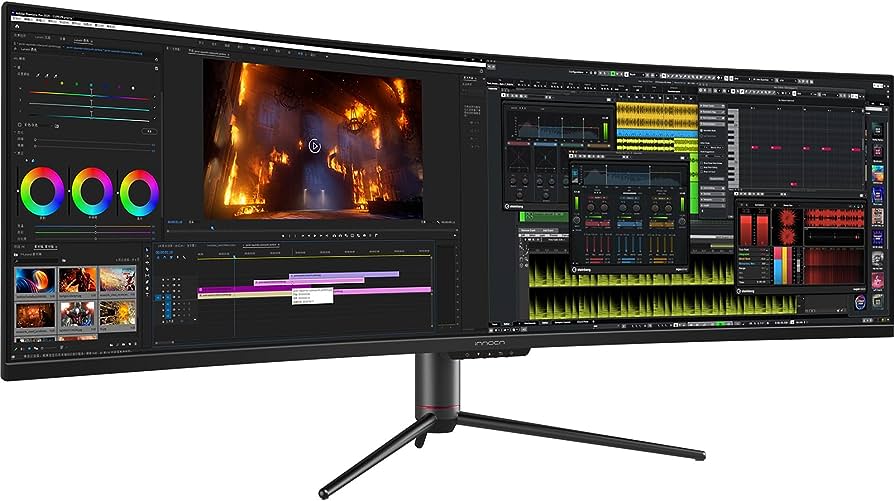Mastering the Visual Realm: A Comprehensive Guide to Choosing the Best Monitors for Video Editing

Introduction:
In the realm of video editing, where precision and color accuracy are paramount, the choice of a monitor becomes a critical factor in achieving professional-grade results. The market is flooded with options, each boasting various specifications and features. In this extensive guide, we will navigate through the complexities of selecting the best monitors for video editing, exploring the key considerations, technical specifications, and top recommendations to empower editors and content creators in their visual endeavors.
Understanding the Unique Demands of Video Editing:
Video editing requires meticulous attention to detail, color accuracy, and a display that faithfully represents the creator’s vision. Factors such as resolution, color space coverage, brightness, and viewing angles play a pivotal role in determining the suitability of a monitor for video editing tasks. Professionals and enthusiasts alike need a monitor that not only provides a clear and detailed view of their work but also ensures consistency across different devices and platforms.
Key Considerations:
- Resolution: The resolution of a monitor is a crucial factor in video editing, influencing the level of detail visible on the screen. Opt for monitors with at least a 4K (3840×2160) resolution for crisp and detailed video editing. Higher resolutions, such as 5K or 6K, can be beneficial for professionals working on ultra-high-definition projects.
- Color Accuracy and Calibration: Accurate color representation is paramount in video editing. Look for monitors that offer high color accuracy and come factory-calibrated. Additionally, monitors with support for color calibration tools, or those that can be easily calibrated using third-party devices, provide the precision needed for color-critical work.
- Color Space Coverage: The color space a monitor covers determines its ability to display a wide range of colors accurately. Monitors that cover a large percentage of color spaces like sRGB, Adobe RGB, or DCI-P3 are ideal for video editing, ensuring that the final product looks consistent across various devices and platforms.
- Panel Technology: Different panel technologies offer varying performance characteristics. In-Plane Switching (IPS) panels are known for their wide viewing angles and accurate color reproduction, making them a popular choice for video editing. However, professionals might also consider high-end panels like Organic Light Emitting Diode (OLED) for superior contrast ratios and deep blacks.
- Brightness and HDR Support: A monitor with sufficient brightness is essential for working in well-lit environments. HDR (High Dynamic Range) support enhances the overall visual experience, providing a broader range of contrast and luminance. Look for monitors with at least 400 nits of brightness and support for HDR10 or Dolby Vision.
- Connectivity: Ensure that the chosen monitor has a variety of connectivity options, including HDMI, DisplayPort, and USB ports. Thunderbolt connectivity can be beneficial for users working with high-speed data transfer and external peripherals.
Top Monitor Recommendations:
- Dell UltraSharp UP3218K: This 32-inch 8K monitor from Dell offers unparalleled resolution and color accuracy. With 100% Adobe RGB and sRGB coverage, along with factory color calibration, it stands out as a top choice for professionals working on high-end video projects.
- LG UltraFine 5K Display: Designed in collaboration with Apple, the LG UltraFine 5K Display features a 27-inch 5K resolution with P3 wide color gamut support. Thunderbolt 3 connectivity provides high-speed data transfer, making it an excellent choice for video editors in the Apple ecosystem.
- ASUS ProArt PA329Q: This 32-inch 4K monitor is a powerhouse for video editing, offering 100% Adobe RGB and sRGB coverage. ASUS ProArt Calibration technology ensures precise color reproduction, making it suitable for professional video editing workflows.
- BenQ SW321C: The SW321C is a 32-inch 4K monitor with comprehensive color support, covering 99% Adobe RGB and 95% DCI-P3. It comes equipped with AQCOLOR technology for accurate color reproduction and features a Paper Color Sync mode for simulating print results.
- EIZO ColorEdge CG319X: Geared towards professional video editing, the ColorEdge CG319X is a 31-inch 4K monitor with 99% Adobe RGB coverage. It boasts advanced color management features, including a built-in colorimeter and support for hardware calibration.
Conclusion:
Selecting the best monitor for video editing is a crucial step in elevating the quality of visual content. The recommendations provided, along with the key considerations outlined, serve as a comprehensive guide for both seasoned professionals and aspiring video editors. Whether working on cinematic masterpieces or YouTube tutorials, the right monitor not only enhances the editing process but also ensures that the final output meets the highest standards of color accuracy and visual fidelity. In the dynamic world of video editing, where every frame counts, investing in the best monitor is an investment in the pursuit of visual excellence.




